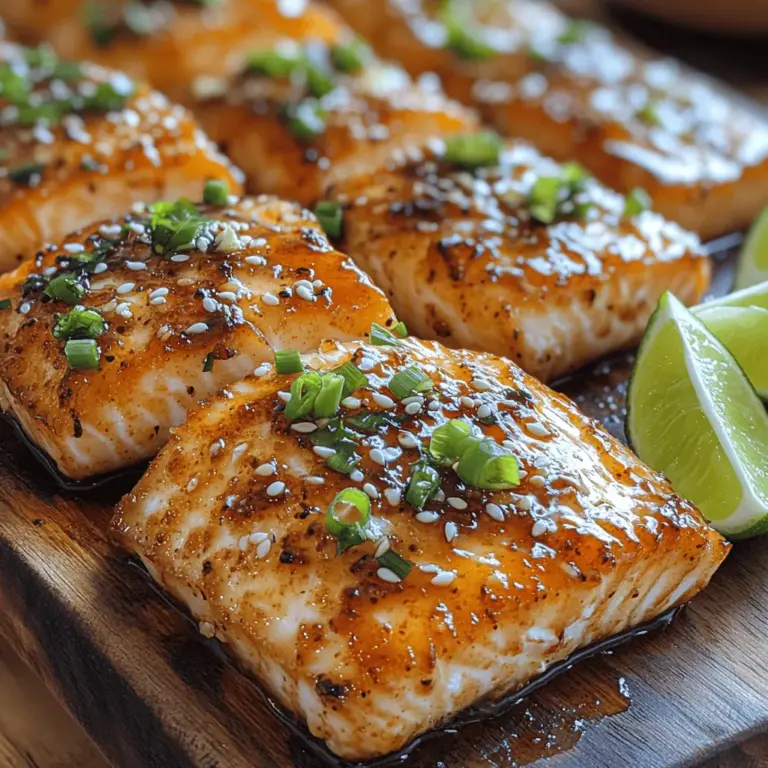Introduction
If you’re looking for a dish that combines delightful flavors with health benefits, look no further than Sweet Soy Glazed Mahi Mahi. This recipe is not just about satisfying your taste buds; it’s a culinary journey that celebrates the exquisite flavors of the ocean. Mahi Mahi, with its firm texture and mild flavor, provides the perfect canvas for a glaze that is sweet, savory, and rich in umami. The marriage of these flavors creates a dish that is both comforting and sophisticated, making it an ideal option for weeknight dinners and special occasions alike.
One of the standout features of this dish is its flavor profile. The sweet soy glaze, made from soy sauce and honey, brings a harmonious blend of sweetness and saltiness, while the addition of garlic and ginger introduces aromatic notes that elevate the dish. This balance makes the Sweet Soy Glazed Mahi Mahi not only delicious but also visually appealing when served alongside vibrant vegetables or fluffy rice.
Beyond its incredible taste, Mahi Mahi is a nutritional powerhouse. Known for its low-calorie content and high protein levels, this fish is an excellent choice for those seeking a healthy diet without compromising on flavor. With abundant omega-3 fatty acids, Mahi Mahi supports heart health, making it a smart choice for health-conscious individuals. In this article, we will delve deeper into Mahi Mahi, explore the ingredients that make this glaze special, and guide you through the steps to create this delightful dish.
Understanding Mahi Mahi
What is Mahi Mahi?
Mahi Mahi, also known as dolphinfish or dorado, is a popular fish found in warm ocean waters, particularly in the tropical and subtropical regions of the Pacific, Atlantic, and Indian Oceans. With its striking golden hues and bright blue-green skin, Mahi Mahi is not only a feast for the palate but also a visual delight. It has a firm texture and a mildly sweet flavor, making it versatile for various cooking methods, including grilling, baking, and pan-searing.
Mahi Mahi is often favored in seafood cuisine because it holds up well to marinades and glazes, allowing it to absorb flavors beautifully without losing its integrity during cooking. Additionally, its adaptability to different flavor profiles—from spicy to sweet—makes it a go-to choice for chefs and home cooks alike.
Nutritional Benefits of Mahi Mahi
When it comes to nutritional value, Mahi Mahi is a frontrunner among seafood options. A typical serving of Mahi Mahi (about 3 ounces) provides approximately 90 calories, making it a low-calorie protein source. It is rich in protein, offering about 20 grams per serving, which is essential for muscle repair and growth. This fish is also a great source of essential vitamins and minerals, including vitamin B12, selenium, and potassium.
One of the key health benefits of Mahi Mahi is its high omega-3 fatty acid content, which is known to promote heart health by reducing inflammation and lowering blood pressure. These healthy fats are crucial for maintaining cardiovascular health and supporting brain function. Furthermore, Mahi Mahi is low in mercury compared to other fish, making it a safer choice for regular consumption, especially for pregnant women and young children.
Why Mahi Mahi Stands Out
While many fish varieties boast similar nutritional benefits, Mahi Mahi stands out for its unique flavor and texture. Unlike other delicate fish types like cod or tilapia, Mahi Mahi’s firm flesh holds up remarkably well under various cooking methods, making it ideal for grilling and broiling. This robustness allows for a variety of culinary approaches, enhancing its versatility in international cuisines.
Additionally, the subtle sweetness of Mahi Mahi pairs beautifully with bold flavors, making it a perfect match for our Sweet Soy Glazed preparation. Its ability to absorb and complement strong marinades without becoming soggy is a significant advantage, setting it apart from many other fish options available in the market.
Ingredients Breakdown
To create the perfect Sweet Soy Glazed Mahi Mahi, it’s essential to understand each ingredient’s role in the recipe. Here’s a detailed breakdown of what you will need:
Mahi Mahi Fillets
The star of our dish is, of course, the Mahi Mahi fillets. When selecting your fillets, look for fresh, firm flesh that is pinkish to white in color. If possible, opt for wild-caught Mahi Mahi, as it tends to have a more robust flavor and better texture compared to farmed varieties. Ideal fillet size for this recipe is about 6 to 8 ounces each, allowing for ample surface area to absorb the glaze without overcooking.
Soy Sauce
Soy sauce acts as the base for our glaze, providing a savory umami flavor that enhances the overall taste of the dish. There are several types of soy sauce available, including regular, low-sodium, and dark soy sauce. For a healthier option, consider using low-sodium soy sauce, which retains the rich flavor while reducing the sodium content. This is particularly beneficial for those watching their salt intake.
Honey versus Maple Syrup
The sweet component of our glaze can be achieved through honey or maple syrup. Both options lend a distinct flavor; honey adds a floral sweetness, while maple syrup provides a deeper, caramel-like essence. From a health perspective, honey is known for its antioxidant properties and has a lower glycemic index than regular sugar, making it a preferable choice for many. However, if you prefer a vegan option, maple syrup would be an excellent substitute.
Rice Vinegar
Rice vinegar plays a crucial role in balancing the flavors of our glaze. Its mild acidity cuts through the sweetness of the honey and the saltiness of the soy sauce, creating a harmonious blend that enhances the dish’s overall flavor profile. If rice vinegar is unavailable, apple cider vinegar can serve as a substitute, though it may impart a slightly different flavor.
Sesame Oil
Adding a drizzle of sesame oil at the end of cooking introduces a nutty richness that complements the other flavors beautifully. This oil is often used in Asian cuisine and provides not only flavor but also healthy fats. Be cautious with the amount, as a little goes a long way in terms of flavor.
Garlic and Ginger
Garlic and ginger are essential aromatics in our marinade, bringing warmth and depth of flavor. They also offer significant health benefits; garlic is known for its immune-boosting properties, while ginger aids digestion and has anti-inflammatory effects. Freshly minced garlic and ginger will provide the best flavor compared to powdered forms.
Cornstarch
Cornstarch is a key ingredient in achieving the ideal glaze consistency. When mixed with the marinade, it acts as a thickening agent, giving the glaze a glossy finish that clings to the Mahi Mahi fillets beautifully. This step is crucial for creating that restaurant-quality appearance and texture.
Garnishes
To elevate the presentation of your Sweet Soy Glazed Mahi Mahi, consider garnishing with sliced green onions and toasted sesame seeds. These garnishes not only add visual appeal but also provide additional flavor and texture, enhancing the overall dining experience.
Preparing the Marinade
Creating the marinade for Sweet Soy Glazed Mahi Mahi is a straightforward process that will significantly enhance the flavor of the fish. Follow these step-by-step instructions:
1. Combine the Ingredients: In a medium bowl, whisk together soy sauce, honey (or maple syrup), rice vinegar, sesame oil, minced garlic, and ginger. Ensure that the honey is fully dissolved in the mixture to achieve a smooth consistency.
2. Add Cornstarch: In a small bowl, mix cornstarch with a tablespoon of cold water to create a slurry. This will help prevent clumping when added to the marinade. Slowly stir this slurry into the marinade mixture, ensuring it is evenly incorporated.
3. Marinate the Fish: Place your Mahi Mahi fillets in a shallow dish or resealable plastic bag. Pour the marinade over the fish, ensuring each piece is well-coated. Cover the dish or seal the bag, then refrigerate for at least 30 minutes or up to 2 hours. This step is crucial as marinating allows the flavors to penetrate the fish, enhancing both taste and moisture.
4. Balance the Flavors: Taste the marinade before marinating the fish. If you prefer a sweeter glaze, add more honey or maple syrup. If you want more acidity, a splash of additional rice vinegar can help balance the sweetness. Adjusting the marinade to your personal preference will ensure a dish tailored to your taste.
5. Prepare to Cook: Once marinated, remove the Mahi Mahi from the refrigerator and let it sit at room temperature for about 15 minutes before cooking. This helps in achieving even cooking.
By following these steps, you’ll create a marinade that not only enhances the flavor of the Mahi Mahi but also ensures a tender, juicy result. The combination of sweet and savory notes will make your Sweet Soy Glazed Mahi Mahi a memorable dish that will surely impress your family and friends.
Stay tuned for the next part of this article, where we will dive into the cooking process, serving suggestions, and tips for achieving the perfect glaze every time.
{{image_1}}
Marinating the Mahi Mahi
Marinating is a crucial step in elevating the flavor and texture of Mahi Mahi. To ensure that your fish absorbs the sweet soy glaze effectively, it is recommended to marinate the Mahi Mahi for at least 30 minutes, but ideally 1-2 hours. For best results, place the fish in a resealable plastic bag or a shallow dish, and pour the marinade over it, ensuring that every piece is well-coated. Seal the bag or cover the dish and refrigerate during the marination process.
The marinating process not only enhances the flavor but also tenderizes the fish. Mahi Mahi, being a lean fish, benefits from the moisture and flavor infusion from the marinade, resulting in a more succulent dish. However, it’s essential to handle raw fish with care. Always use clean utensils and surfaces to prevent cross-contamination, and wash your hands thoroughly after handling the fish. If you’re marinating for an extended period, ensure that the fish is kept at a safe temperature in the refrigerator to avoid any foodborne illnesses.
Cooking the Mahi Mahi
The cooking method chosen for Mahi Mahi significantly impacts the final texture and flavor of the dish. Pan-searing is an excellent option, as it allows for a beautifully crisp exterior while keeping the inside moist and flaky. To pan-sear the Mahi Mahi, begin by heating a non-stick skillet or cast-iron pan over medium-high heat. Add a splash of oil, such as canola or avocado oil, which can withstand high temperatures.
It’s essential to wait until the oil is shimmering before adding the fish. This indicates that the oil is hot enough to create a nice sear. Carefully place the marinated Mahi Mahi fillets in the skillet, ensuring not to overcrowd the pan, as this can lower the temperature and lead to steaming rather than searing.
Cook the fish for about 4-5 minutes on one side without moving it, allowing a golden crust to form. Flip the fillets gently using a spatula and cook for an additional 3-4 minutes on the other side. The Mahi Mahi is done when it is golden brown and flakes easily with a fork. Keep an eye on the fillets; overcooking can lead to a dry texture, so monitoring the cooking time is crucial.
Creating the Glaze
While the Mahi Mahi is cooking, it’s time to prepare the sweet soy glaze. Start by taking the leftover marinade (if using a separate batch for glazing, ensure it has not come into contact with raw fish) and pour it into a small saucepan. Bring the marinade to a gentle simmer over medium heat. This step is crucial, as it helps to kill any harmful bacteria that may have been present in the raw fish.
To thicken the glaze, you’ll need to add cornstarch. In a small bowl, mix a teaspoon of cornstarch with a tablespoon of cold water to create a slurry. Once the marinade reaches a simmer, slowly whisk in the cornstarch slurry. Continue to simmer the mixture for an additional 2-3 minutes until it thickens to a syrupy consistency. The glaze should coat the back of a spoon and have a glossy appearance. If it’s too thick, you can thin it out with a little water, adjusting to your desired texture.
Glazing the Fish
After pan-searing the Mahi Mahi, it’s time to apply the glaze. Reduce the heat to low and pour the thickened glaze over the fish in the skillet. Use a spoon to baste the fish with the glaze, ensuring that each fillet is well-coated. This step not only adds flavor but also creates a beautiful, shiny finish on the fish.
Continue cooking the fish for an additional 2-3 minutes, allowing the glaze to caramelize slightly and infuse the Mahi Mahi with its sweet and savory notes. Watch for visual cues indicating that the fish is perfectly glazed; the glaze should become slightly sticky and adhere well to the fish. The fish will take on a beautiful sheen and should still be moist inside.
Serving Suggestions
Presentation plays a vital role in enhancing the dining experience. Once the Mahi Mahi is cooked and glazed, transfer the fillets to a serving platter. To create an appealing dish, consider garnishing with finely chopped scallions or sesame seeds for added texture and color.
As for side dishes, Mahi Mahi pairs beautifully with a variety of accompaniments. Consider serving it over a bed of jasmine rice or quinoa, which can absorb the delicious flavors of the glaze. Steamed vegetables, such as broccoli, asparagus, or snap peas, provide a bright contrast and add nutritional value to the meal.
Don’t forget to include lime wedges on the side. A squeeze of fresh lime juice over the glazed Mahi Mahi brightens the dish and enhances the sweet and savory flavors of the glaze, making every bite even more refreshing.
Conclusion
In conclusion, the Sweet Soy Glazed Mahi Mahi is more than just a meal; it’s a delightful celebration of flavors and textures that showcases the versatility of this delectable fish. The marinating process enriches the Mahi Mahi with flavor, while pan-searing creates a delightful crust. The glaze brings everything together, creating a dish that is not only visually appealing but also packed with taste.
Encouraging you to give this recipe a try at home, it offers a quick, flavorful, and healthy option for any weeknight dinner or special occasion. With its rich flavor profile and the ease of preparation, Mahi Mahi holds a special place in various cuisines around the world. Whether served with rice, vegetables, or a fresh salad, this dish is sure to impress family and friends alike. Enjoy the journey of cooking this delightful meal and savor the flavors that await!



